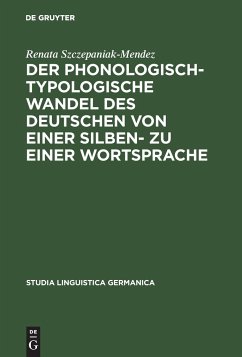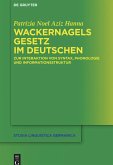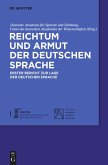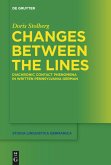The subject of this volume is the far-reaching phonological change which the German language has gone through during its history and which has led to a fundamental typological reorientation of the language. Whereas Old High German was clearly assigned to the typological pole of syllable languages, Modern German has developed into a pronouncedword language that disregards the syllable. With the help of this typological model, all phonological changes can be described far more adequately than ever before. After introducing the concepts of syllable andword language, the volume moves on to describe the phonological-typological changes which have taken place in the history of the German language. Distinguishing features of this volume are its comprehensibility and numerous examples.
Gegenstand dieser Arbeit ist die phonologische Entwicklung des Deutschen aus typologischer Perspektive. War das Althochdeutsche noch eindeutig dem typologischen Pol der Silbensprache zuzuordnen, so hat sich das heutige Deutsch zu einer ausgeprägten Wortsprache entwickelt, die die Silbe vernachlässigt und stattdessen das Wort optimiert und exponiert. Sämtliche phonologischen Veränderungen, darunter auch die 2. Lautverschiebung oder der ahd. i-Umlaut lassen sich mithilfe dieses typologischen Modells adäquater als bisher darstellen und erfahren vor allem eine Neubewertung sowie eine übergreifende Erklärung. Die Arbeit stellt zunächst das Konzept der Silben- bzw. Wortsprache vor, um anschließend detailliert - nach den einzelnen Sprachperioden geordnet - auf den phonologisch-typologischen Wandel in der deutschen Sprachgeschichte einzugehen. Dabei wird deutlich, dass das Mittelhochdeutsche die wichtigste Umbruchphase darstellt, in der die Silbensprachlichkeit abgebaut und die Wortsprachlichkeit (langsam) aufgebaut wird (z.B. Zentralisierung der unbetonten Vokale, die Herausbildung des Silbenschnitts sowie extrasilbischer und ambisilbischer Konsonanten). Dieser Prozess dauert bis heute an.
Gegenstand dieser Arbeit ist die phonologische Entwicklung des Deutschen aus typologischer Perspektive. War das Althochdeutsche noch eindeutig dem typologischen Pol der Silbensprache zuzuordnen, so hat sich das heutige Deutsch zu einer ausgeprägten Wortsprache entwickelt, die die Silbe vernachlässigt und stattdessen das Wort optimiert und exponiert. Sämtliche phonologischen Veränderungen, darunter auch die 2. Lautverschiebung oder der ahd. i-Umlaut lassen sich mithilfe dieses typologischen Modells adäquater als bisher darstellen und erfahren vor allem eine Neubewertung sowie eine übergreifende Erklärung. Die Arbeit stellt zunächst das Konzept der Silben- bzw. Wortsprache vor, um anschließend detailliert - nach den einzelnen Sprachperioden geordnet - auf den phonologisch-typologischen Wandel in der deutschen Sprachgeschichte einzugehen. Dabei wird deutlich, dass das Mittelhochdeutsche die wichtigste Umbruchphase darstellt, in der die Silbensprachlichkeit abgebaut und die Wortsprachlichkeit (langsam) aufgebaut wird (z.B. Zentralisierung der unbetonten Vokale, die Herausbildung des Silbenschnitts sowie extrasilbischer und ambisilbischer Konsonanten). Dieser Prozess dauert bis heute an.








